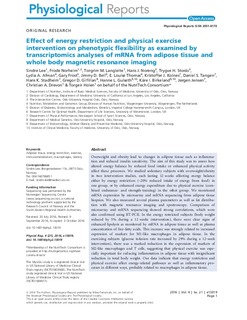| dc.contributor.author | Lee, Sindre | |
| dc.contributor.author | Norheim, Frode | |
| dc.contributor.author | Langleite, Torgrim M. | |
| dc.contributor.author | Noreng, Hans J. | |
| dc.contributor.author | Storås, Trygve H. | |
| dc.contributor.author | Afman, Lydia A. | |
| dc.contributor.author | Frost, Gary | |
| dc.contributor.author | Bell, Jimmy D. | |
| dc.contributor.author | Thomas, E. Louise | |
| dc.contributor.author | Kolnes, Kristoffer J. | |
| dc.contributor.author | Tangen, Daniel S. | |
| dc.contributor.author | Stadheim, Hans Kristian | |
| dc.contributor.author | Gilfillan, Gregor D. | |
| dc.contributor.author | Gulseth, Hanne L. | |
| dc.contributor.author | Birkeland, Kåre I. | |
| dc.contributor.author | Jensen, Jørgen | |
| dc.contributor.author | Drevon, Christian A. | |
| dc.contributor.author | Holen, Torgeir | |
| dc.date.accessioned | 2017-02-01T13:36:42Z | |
| dc.date.available | 2017-02-01T13:36:42Z | |
| dc.date.issued | 2016-11-07 | |
| dc.identifier.citation | Physiological Reports. 2016, 4. doi: 10.14814/phy2.13019 | nb_NO |
| dc.identifier.uri | http://hdl.handle.net/11250/2429169 | |
| dc.description.abstract | Overweight and obesity lead to changes in adipose tissue such as inflammation and reduced insulin sensitivity. The aim of this study was to assess how altered energy balance by reduced food intake or enhanced physical activity affect these processes. We studied sedentary subjects with overweight/obesity in two intervention studies, each lasting 12 weeks affecting energy balance either by energy restriction (~20% reduced intake of energy from food) in one group, or by enhanced energy expenditure due to physical exercise (combined endurance‐ and strength‐training) in the other group. We monitored mRNA expression by microarray and mRNA sequencing from adipose tissue biopsies. We also measured several plasma parameters as well as fat distribution with magnetic resonance imaging and spectroscopy. Comparison of microarray and mRNA sequencing showed strong correlations, which were also confirmed using RT‐PCR. In the energy restricted subjects (body weight reduced by 5% during a 12 weeks intervention), there were clear signs of enhanced lipolysis as monitored by mRNA in adipose tissue as well as plasma concentration of free‐fatty acids. This increase was strongly related to increased expression of markers for M1‐like macrophages in adipose tissue. In the exercising subjects (glucose infusion rate increased by 29% during a 12‐week intervention), there was a marked reduction in the expression of markers of M2‐like macrophages and T cells, suggesting that physical exercise was especially important for reducing inflammation in adipose tissue with insignificant reduction in total body weight. Our data indicate that energy restriction and physical exercise affect energy‐related pathways as well as inflammatory processes in different ways, probably related to macrophages in adipose tissue. | nb_NO |
| dc.language.iso | eng | nb_NO |
| dc.publisher | American Physiological Society | nb_NO |
| dc.subject | adipose tissue | nb_NO |
| dc.subject | energy restriction | nb_NO |
| dc.subject | exercise | nb_NO |
| dc.subject | immunometabolism | nb_NO |
| dc.subject | macrophages | nb_NO |
| dc.subject | obesity | nb_NO |
| dc.title | Effect of energy restriction and physical exercise intervention on phenotypic flexibility as examined by transcriptomics analyses of mRNA from adipose tissue and whole body magnetic resonance imaging | nb_NO |
| dc.type | Journal article | nb_NO |
| dc.type | Peer reviewed | nb_NO |
| dc.subject.nsi | VDP::Medisinske Fag: 700::Basale medisinske, odontologiske og veterinærmedisinske fag: 710::Human og veterinærmedisinsk fysiologi: 718 | nb_NO |
| dc.source.journal | Physiological Reports | nb_NO |
| dc.identifier.doi | 10.14814/phy2.13019 | |
| dc.description.localcode | Seksjon for fysisk prestasjonsevne / Department of Physical Performance | nb_NO |
